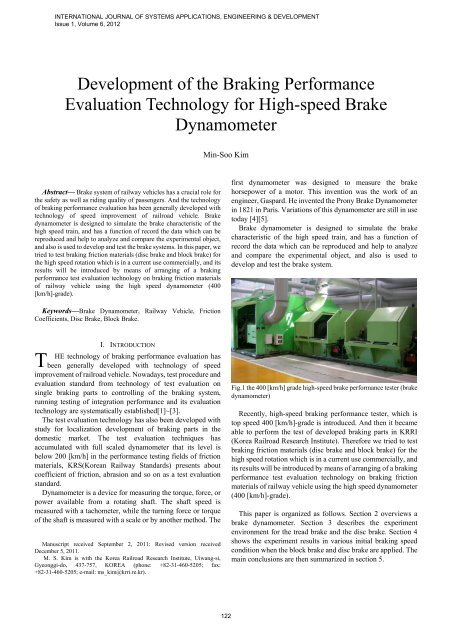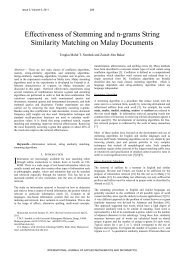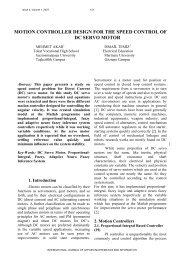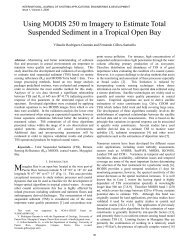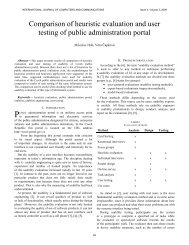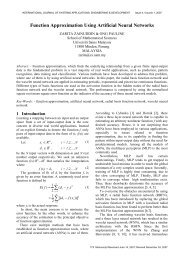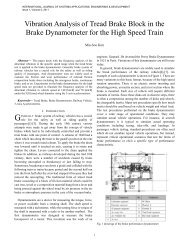Development of the Braking Performance ... - university press
Development of the Braking Performance ... - university press
Development of the Braking Performance ... - university press
You also want an ePaper? Increase the reach of your titles
YUMPU automatically turns print PDFs into web optimized ePapers that Google loves.
INTERNATIONAL JOURNAL OF SYSTEMS APPLICATIONS, ENGINEERING & DEVELOPMENTIssue 1, Volume 6, 2012Fig.4 <strong>the</strong> shape <strong>of</strong> braking test and <strong>the</strong>rmal band observed on <strong>the</strong> wheelwhen it is on brakingTable 2 dynamometer test program (block brake)Air <strong>press</strong>ureforceInitial velocityThe number <strong>of</strong>testsB. Test MethodThe test for measuring <strong>the</strong> friction coefficient was carried outwith reference to UIC 541-3 provisions, tests were conductedafter obtaining more than 80% friction surface <strong>of</strong> braking padthrough adequate pre-test (bedding) prior to <strong>the</strong> main test. Thetest was performed in braking initial temperature as 60 ° C.We executed <strong>the</strong> test in accordance with various initialspeed <strong>of</strong> braking respectively in order to comprehend <strong>the</strong>characteristics <strong>of</strong> high-speed braking system. In two kinds <strong>of</strong>conditions <strong>of</strong> air <strong>press</strong>ure force (two conditions: 15 and 22.5[kN]), <strong>the</strong> braking test executed in <strong>the</strong> order <strong>of</strong>120,160,200,300 km/h.The actual braking tests look like this Fig.6, <strong>the</strong>rmal band in<strong>the</strong> disc surface is formed like this figure and <strong>the</strong> surfacemorphology <strong>of</strong> speculated as <strong>the</strong> formation <strong>of</strong> hot spots wasobserved after braking stopping.[kN] [km/h] Dry16.65.9801201602008012016020025030001020304050607080910IV. PERFORMANCE TEST OF DISC BRAKEA. The Test Outline and MaterialThis test is as a test for <strong>the</strong> brake disc pads, refers to a test toassess <strong>the</strong> safety by verifying <strong>the</strong> performance <strong>of</strong> <strong>the</strong> brake padtests were conducted with reference to UIC specification(UIC541-3“Brakes-Disc brakes and <strong>the</strong>ir application-Generalconditions for <strong>the</strong> approval <strong>of</strong> brake pads”), braking pad isapplied to <strong>the</strong> current KTX as <strong>the</strong> pad and <strong>the</strong> shape <strong>of</strong> <strong>the</strong> padis shown in <strong>the</strong> Fig. 5 [16].Material is composed <strong>of</strong> sintered metal, heat capacity and<strong>the</strong>rmal conductivity is respectively 600 [J kg ℃], 25 [W m ℃].Fig.6 <strong>the</strong> shape <strong>of</strong> hot spot is observed when stopping, <strong>the</strong>rmal band isobserved when testing <strong>of</strong> braking discTable 3 dynamometer test program (disc brake)Air <strong>press</strong>ureforceInitial velocity[kN] [km/h] DryThe number <strong>of</strong>testsFig.5 <strong>the</strong> shape <strong>of</strong> <strong>the</strong> brake pad for <strong>the</strong> disc brake1512016020030001020304124
INTERNATIONAL JOURNAL OF SYSTEMS APPLICATIONS, ENGINEERING & DEVELOPMENTIssue 1, Volume 6, 2012Fig.10 <strong>the</strong> change on instantaneous coefficient <strong>of</strong> friction in brakinginitial speed 160 [km/h] (at wheel contact force 16.6 [kN])Fig.14 <strong>the</strong> change on instantaneous coefficient <strong>of</strong> friction in brakinginitial speed 160 [km/h] (at wheel contact force 5.9 [kN])Fig.11 <strong>the</strong> change on instantaneous coefficient <strong>of</strong> friction in brakinginitial speed 200 [km/h] (at wheel contact force 16.6 [kN])Fig.15 <strong>the</strong> change on instantaneous coefficient <strong>of</strong> friction in brakinginitial speed 200 [km/h] (at wheel contact force 5.9 [kN])Fig.12 <strong>the</strong> change on instantaneous coefficient <strong>of</strong> friction in brakinginitial speed 80 [km/h] (at wheel contact force 5.9 [kN])Fig.16 <strong>the</strong> change on instantaneous coefficient <strong>of</strong> friction in brakinginitial speed 250 [km/h] (at wheel contact force 5.9 [kN])Fig.13 <strong>the</strong> change on instantaneous coefficient <strong>of</strong> friction in brakinginitial speed 120 [km/h] (at wheel contact force 5.9 [kN])Fig.17 <strong>the</strong> change on instantaneous coefficient <strong>of</strong> friction in brakinginitial speed 300 [km/h] (at wheel contact force 5.9 [kN])126
INTERNATIONAL JOURNAL OF SYSTEMS APPLICATIONS, ENGINEERING & DEVELOPMENTIssue 1, Volume 6, 2012Friction coefficients were obtained ranging from 0.293 to0.384 in <strong>the</strong> condition <strong>of</strong> air <strong>press</strong>ure force 5.9 [kN] (<strong>the</strong> air<strong>press</strong>ure force is lower than above condition), we can get <strong>the</strong>result that high friction coefficient was obtained in <strong>the</strong>condition <strong>of</strong> low air <strong>press</strong>ure force.C. Average Coefficient <strong>of</strong> Friction <strong>of</strong> Disc BrakeThe average coefficient <strong>of</strong> friction each initial speed <strong>of</strong>braking is shown in <strong>the</strong> table 5. The average coefficient <strong>of</strong>friction means <strong>the</strong> average value <strong>of</strong> <strong>the</strong> friction coefficientduring braking, we found that <strong>the</strong> higher initial braking velocitygets, <strong>the</strong> lower average coefficient <strong>of</strong> friction gets typically inless than 200 [km/h]. Similar trend were presented in condition<strong>of</strong> disc contact force 15 [kN] and 22.5 [kN],Average coefficient <strong>of</strong> friction like 0.344 to 0.412 are shownin braking initial speed less than 200 [km/h].The average coefficient <strong>of</strong> friction each braking initialvelocity was obtained from data analysis <strong>of</strong> brakingcharacteristics, detailed results <strong>of</strong> <strong>the</strong> instantaneous coefficient<strong>of</strong> friction <strong>of</strong> disc brake were shown in <strong>the</strong> following figures.Table 5 results <strong>of</strong> <strong>the</strong> average coefficient <strong>of</strong> friction <strong>of</strong> brake shoeNo. Speed Test Max Remarks(km/h) Result( μ )Temp( ℃ )1 120 0.381 110.72 160 0.451 135.33 200 0.462 191.44 300 0.360 249.35 120 0.344 107.46 160 0.380 157.07 200 0.412 200.08 300 0.330 257.4Fig.19 <strong>the</strong> change on instantaneous coefficient <strong>of</strong> friction in brakinginitial speed 160 [km/h] (at disc contact force 15 [kN])Fig.20 <strong>the</strong> change on instantaneous coefficient <strong>of</strong> friction in brakinginitial speed 200 [km/h] (at disc contact force 15 [kN])D. The Instantaneous Coefficient <strong>of</strong> Friction <strong>of</strong> Disc BrakeIn general, friction coefficients were obtained ranging from0.330 to 0.412 in 120~300 [km/h] speed in <strong>the</strong> condition <strong>of</strong> air<strong>press</strong>ure force 22.5 [kN].Fig.21 <strong>the</strong> change on instantaneous coefficient <strong>of</strong> friction in brakinginitial speed 300 [km/h] (at disc contact force 15 [kN])Fig.18 <strong>the</strong> change on instantaneous coefficient <strong>of</strong> friction in brakinginitial speed 120 [km/h] (at disc contact force 15 [kN])127
INTERNATIONAL JOURNAL OF SYSTEMS APPLICATIONS, ENGINEERING & DEVELOPMENTIssue 1, Volume 6, 2012Fig.21 <strong>the</strong> change on instantaneous coefficient <strong>of</strong> friction in brakinginitial speed 120 [km/h] (at disc contact force 22.5 [kN])Fig.22 The change on instantaneous coefficient <strong>of</strong> friction in brakinginitial speed 160 [km/h] (at disc contact force 22.5 [kN])Fig.23 The change on instantaneous coefficient <strong>of</strong> friction in brakinginitial speed 200 [km/h] (at disc contact force 22.5 [kN])Fig.24 <strong>the</strong> change on instantaneous coefficient <strong>of</strong> friction in brakinginitial speed 300 [km/h] (at disc contact force 22.5 [kN])Friction coefficients were obtained ranging from 0.360 to0.462 in <strong>the</strong> condition <strong>of</strong> air <strong>press</strong>ure force 15[kN] (<strong>the</strong> air<strong>press</strong>ure force is lower than above condition), we can get <strong>the</strong>result that high friction coefficient was obtained in <strong>the</strong>condition <strong>of</strong> low air <strong>press</strong>ure force.VI. CONCLUSIONIn this paper, measurement test <strong>of</strong> coefficient <strong>of</strong> friction wasintroduced about braking shoe and disc pad for development <strong>of</strong>performance test technology using 400 [km/h]-gradehigh-speed braking performance tester. And test standard <strong>of</strong>braking friction material using high-speed tester wassummarized.Also, braking characteristics <strong>of</strong> friction material on <strong>the</strong> topspeed 300 [km/h] were considered, average and instantaneouscoefficient <strong>of</strong> friction was obtained.It is possible to secure performance test technology forconducting performance test <strong>of</strong> <strong>the</strong> future new braking based on<strong>the</strong> result <strong>of</strong> this study. It have been identified that can beutilized not only evaluation on friction characteristics <strong>of</strong>braking friction materials but also braking disc or development<strong>of</strong> wheel.REFERENCES[1] Simon Iwnicki, Handbook <strong>of</strong> Railway Vehicle Dynamic, CRC Press,2006.[2] Robert L. J., Railway Brakes, Autralia: Westinghouse Brake and SingnalCo., 1982.[3] Garg V. K. and Rukkipati R. V., Dynamics <strong>of</strong> Railway Vehicle Systems,Academic <strong>press</strong>, 1994.[4] T. E. Johnson, Results <strong>of</strong> Dynamometer Tests <strong>of</strong> Brake Shoes Under FullLoad Conditions, Illinois : Association <strong>of</strong> American Railroads, 1993[5] Hecht Basch, R., Fash, J., Hasson, R., Dalka, T., McCune, R. and Kafold,R. “Initial Dynamometer and Laboratory Evaluations <strong>of</strong> ThermallySprayed Aluminium Brake Discs,” In Brakes 2000, InternationalConference on Automotive <strong>Braking</strong> Technologies for <strong>the</strong> 21st Century, pp.163-173, 2000.[6] M. Tirovic, A. J. Day, “Disc Bake Interface Pressure Distribution,”Proceedings IMechE, Vol 205, pp. 137~146, 1991.[7] T. K. Kao, J. W. Richmond and M. W. Moore, “Computational Analysis<strong>of</strong> Disc Pad <strong>Performance</strong>.” Proceedings IMechE, C444 /02793, pp. 1-12,1993.[8] P. G. Lohmeier, “Brake Systems for Modern Rapid Transit Traffic,”Conference on Railway Engineering, pp. 163~168, 1985.[9] GEC Alsthom Transport SA, “<strong>Braking</strong> System for a Rail Vehicle usingMaterials based on Carbon,” US Patent 5, 407, 032, 1995.[10] Harper, Graham A., Brakes and friction materials : <strong>the</strong> history anddevelopment <strong>of</strong> <strong>the</strong> technologies, London : MEP (Mechanical EngineeringPublication, 1998[11] QUESTION B-169: Selection <strong>of</strong> parameters for testing <strong>the</strong>rmal limits <strong>of</strong>wheels and brake blocks, Utrecht: ERRI, 1989.[12] M. C. Fec, H. Sehitoglu, Thermal limits for wheels and brake blocks:monitoring <strong>of</strong> solid wheels in service (Report No. R-600), Utrecht: ERRI,1995.[13] Aviles, R., Hennequet, G., Hernandez, A. and Llorente, L. I. “LowFrequency Vibrations in Disc Brakes at High Car Speed. Part I:Experimental Approach,” Int. Journal <strong>of</strong> Vehicle Dynamics, 1995, 16(6),542-555.[14] Lang, A. M. and Smales, H. “An Approach to <strong>the</strong> Solution <strong>of</strong> Disc BrakeVibration Problems,” In Proceedings, <strong>Braking</strong> <strong>of</strong> Road Vehicles, London,1983.[15] UIC CODE 541-1 Brakes – Regulations concerning <strong>the</strong> design <strong>of</strong> brakecomponents, 6 th Eds. November 2003.[16] UIC CODE 541-3 Brakes – Disc brakes and <strong>the</strong>ir application – Generalconditions for <strong>the</strong> approval <strong>of</strong> brake pads, 6 th Eds. November 2006.[17] UIC CODE 541-4 Brakes – Brakes with composite brake blocks –General conditions for certification <strong>of</strong> composite brake blocks, 3 rd Eds.May 2007.[18] M-S Kim, J-H Park, B-C Goo, “<strong>Development</strong> <strong>of</strong> Brake System <strong>of</strong> RailwayVehicles for Real-Time HILS,” The 2007 International Conference onMechatronics and Information Technologys(ICMIT 2007), Gifu, Japan,5-6 December, 2007.128
INTERNATIONAL JOURNAL OF SYSTEMS APPLICATIONS, ENGINEERING & DEVELOPMENTIssue 1, Volume 6, 2012[19] M-S Kim, H-M Hur, “<strong>Braking</strong>/Traction Control Systems <strong>of</strong> a ScaledRailway Vehicle for <strong>the</strong> Active Steering Testbed,” The 9th WSEASInternational Conference on Robotics, Control and ManufacturingTechnology, Hangzhou, China, May 20-22, 2009.[20] M-S Kim, H-M Hur, “Application <strong>of</strong> <strong>Braking</strong>/Traction Control Systemsto <strong>the</strong> Scaled Active Steering Testbed in <strong>the</strong> Railway Vehicle,” WSEASTransactions on System and Control, 2009.[21] M-S Kim J-G Kim, B-C Goo, N-P Kim, “Frequency Analysis <strong>of</strong> <strong>the</strong>Vibration <strong>of</strong> Tread Brake Dynamometer for <strong>the</strong> High Speed Train,” The10th WSEAS International Conference on Signal Processing,Computational Geometry and Artificial Vision, Taipei, Taiwan, August20-22, 2010.[22] M-S Kim, “Vibration Analysis <strong>of</strong> Tread Brake Block in <strong>the</strong> BrakeDynamometer for <strong>the</strong> High Speed Train,” International Journal <strong>of</strong>Systems Applications, Engineering & <strong>Development</strong>, Issue 1, Volume 5,2011.[23] M-S Kim, J-G Kim, B-C Go and N-P Kim, “Comparative Studies <strong>of</strong> <strong>the</strong>Tread Brake Dynamometer between Dry and Wet Conditions,” 9thWSEAS Int.Conf. on System Science and Simulation in Engineering, Iwate,Japan, October 4-6, 2010[24] M-S Kim, “Dynamometer Tests <strong>of</strong> Brake Shoes under Wet Conditions for<strong>the</strong> High Speed Trains,” International Journal <strong>of</strong> Systems Applications,Engineering & <strong>Development</strong>, Issue 2, Volume 5, 2011.[25] M-S Kim, J-G Kim and B-C Go, “<strong>Development</strong> <strong>of</strong> <strong>the</strong> EvaluationTechnology <strong>of</strong> <strong>the</strong> <strong>Braking</strong> Test for High-speed Brake <strong>Performance</strong>Tester,” The 4th WSEAS International Conference on Visualization,Imaging and Simulation, Catania, Italy, November 3~5, 2011.Min-Soo Kim received <strong>the</strong> B.S., M.S., and Ph.D. degrees in electricalengineering from Soongsil University, Seoul, Korea in 1995, 1997, and 2003,respectively. From December 2005 he is a senior researcher at <strong>the</strong> Radio-basedTrain Control Research Team, Metropolitan Railroad Systems Research Center,at Korea Railroad Research Institute, 360-1 Woram-dong, Uiwang-si,Kyonggi-do, 437-757 Korea (corresponding author to provide phone:+82-31-460-5205; fax: +82-31-460-5449; e-mail: ms_kim@krri.re.kr). Hisresearch interests include control systems design <strong>of</strong> railway vehicle anddynamometer test for <strong>the</strong> railway brake components.129


